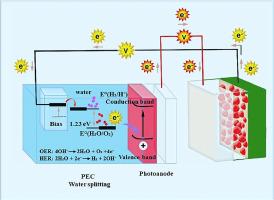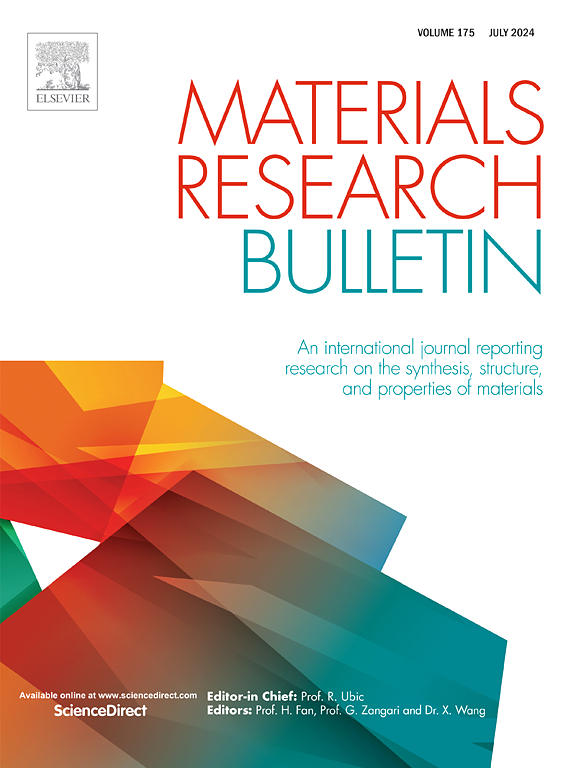Advanced plasmonic few-layered InSe nanosheet heterojunctions for enhanced photoelectrochemical water splitting
IF 5.3
3区 材料科学
Q2 MATERIALS SCIENCE, MULTIDISCIPLINARY
引用次数: 0
Abstract
The selenide-based Van der Waals heterojunctions show great potential for the next generation of photoelectronic nanodevices. Herein, we construct a 2D photoanode nanocatalyst that consists of ZnSe nanocrystals with exposed active surfaces coupled with few-layered InSe nanosheets decorated by Au nanoparticles. The resultant ZnSe/AuNPs@InSe multi-heterojunction photoanode demonstrates an outstanding photocurrent density of 4.86 mAcm−2 under AM 1.5 G simulated sunlight (100 mWcm−2), which is 8 times greater than that of the pristine InSe photoanode (0.61 mAcm−2). Moreover, the lifetime of photogenerated charge carriers is extended by a factor of 3. This significant enhancement in photoelectrochemical water splitting in the near-infrared region is attributed to the surface plasmonic effect produced by the modification of Au NPs when bulk InSe is exfoliated into multi-layered flakes. The interfacial coupling effects on carrier transfer dynamics, as revealed by impedance spectroscopy assisted with the First-Principal calculations, show that this photoanode significantly minimizes the internal resistance, boosts the charge carrier separation efficiency, and promotes water oxidation.

用于增强光电化学水分离的先进等离子少层铟硒纳米片异质结
基于硒化物的范德华异质结在下一代光电子纳米器件中显示出巨大的潜力。在这里,我们构建了一种二维光阳极纳米催化剂,它由具有暴露活性表面的 ZnSe 纳米晶体和由金纳米粒子装饰的少层 InSe 纳米片组成。由此产生的 ZnSe/AuNPs@InSe 多异质结光电阳极在 AM 1.5 G 模拟太阳光(100 mWcm-2)下的光电流密度高达 4.86 mAcm-2,是原始 InSe 光电阳极(0.61 mAcm-2)的 8 倍。这种近红外区域光电化学分水效应的显著增强归功于块状 InSe 剥离成多层薄片时,金 NPs 修饰产生的表面等离子效应。阻抗光谱和第一原理计算揭示了界面耦合对载流子传输动力学的影响,表明这种光阳极能显著降低内阻、提高电荷载流子分离效率并促进水氧化。
本文章由计算机程序翻译,如有差异,请以英文原文为准。
求助全文
约1分钟内获得全文
求助全文
来源期刊

Materials Research Bulletin
工程技术-材料科学:综合
CiteScore
9.80
自引率
5.60%
发文量
372
审稿时长
42 days
期刊介绍:
Materials Research Bulletin is an international journal reporting high-impact research on processing-structure-property relationships in functional materials and nanomaterials with interesting electronic, magnetic, optical, thermal, mechanical or catalytic properties. Papers purely on thermodynamics or theoretical calculations (e.g., density functional theory) do not fall within the scope of the journal unless they also demonstrate a clear link to physical properties. Topics covered include functional materials (e.g., dielectrics, pyroelectrics, piezoelectrics, ferroelectrics, relaxors, thermoelectrics, etc.); electrochemistry and solid-state ionics (e.g., photovoltaics, batteries, sensors, and fuel cells); nanomaterials, graphene, and nanocomposites; luminescence and photocatalysis; crystal-structure and defect-structure analysis; novel electronics; non-crystalline solids; flexible electronics; protein-material interactions; and polymeric ion-exchange membranes.
 求助内容:
求助内容: 应助结果提醒方式:
应助结果提醒方式:


